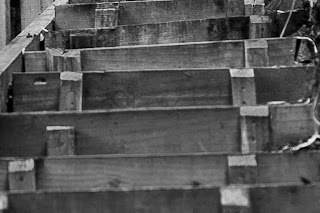Exercise: Diagonals
We were asked to take 4 photographs which use diagonals. One thing I have noticed whilst doing this exercise, is that it is easy to create diagonals by canting the frame. Diagonal lines produce movement, dynamism .. they are highly active.. and bring life into the picture because they represent unresolved tension (1).
1. there are parallel diagonals here, the branch going left to upper right and the individual leaves forming diagonals off the branch.
3. movement is present, the columns form diagonals in one direction, whilst the top diagonal line of the building pulls the eye in another direction demonstrating unresolved tension.
4. I spotted this diagonal shadow forming across the bottom of the statue -
5. the staircase is a natural diagonal, I originally canted the frame to get an abstract view of the tower, in doing so, the tower itself creates a diagonal suggesting movement, perspective and depth.
Conclusion:
Horizontals and verticals lines produce stability which arise from their symbolic associations with gravity. Diagonals have a stronger sense of movement and expression. As I experienced in this exercise, diagonals can be created in the viewfinder by canting the frame - as Freeman notes, this ability means that they are much more under the control of the photographer(2). Diagonals emphasise depth and distance, I have looked back through the early exercises in Part One, and noticed that I had quite a few diagonals emphasising depth and distance. I am now able to appreciate that diagonals form strong graphic points of reference, or movement.
Reflection: whilst, participating in these exercises, I have been inspired to read about Cubism and its response to the Renaissance order of painting. I have always liked Mondrian, especially his later works, with lines and three colours. I am now able to understand a bit more about the graphic qualities in his drawings. http://www.theartstory.org/artist-mondrian-piet.htm, and http://www.moma.org/collection/provenance/provenance_object.php?object_id=79879.
Trafalgar Square by Mondrian http://www.moma.org/collection/provenance/provenance_object.php?object_id=79879 (accessed 19/9/12)
(1)Freeman, Michael, (2007). The Photographer's Eye: Composition and Design for Better Digital Photos, The Ilex Press. p 76 -77
(2)Freeman, Michael, (2007). The Photographer's Eye: Composition and Design for Better Digital Photos, The Ilex Press. p 76 -77




















